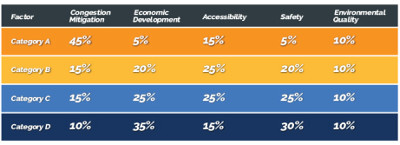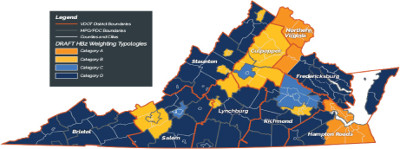The Commonwealth Transportation Board (CTB) developed the HB2 Prioritization Process in an effort to fairly evaluate transportation projects across allregions of the state.
We spoke with Kimberly Pryor, director of the Infrastructure Investment Division of at the Virginia Department of Transportation (VDOT), to learn first-hand about the scoring process as it’s carried out for the first time. “The intent is to take politics out of the process so projects have to demonstrate need,” Pryor said.
Projects will be scored using six factors—safety, congestion mitigation, economic development, accessibility, environmental quality and land use. The total scores are then divided by the financial cost of the project. Dividing by cost is the factor that allows rural communities an opportunity to compete with heavily populated, more congested urban areas, as transportation projects in those areas tend to cost less. And the cheaper the project, the higher it will be scored. In addition, when localities and public transit agencies apply, they can agree to pay a portion of the cost, which will help boost their scores because less money will have to come from HB2.
Creating a fair scoring process proved to be challenging since “Virginia is not a homogenous state; there are intensely urban and very rural areas, which is part of the need for the typologies,” according to Pryor.
Typologies Data Credit: Virginia Department of Transportation
(Click images to view in full size.)

 Factors will differ in importance depending on which part of the state you call home. For instance, congestion mitigation will be crucial to Arlington, but Abingdon will be more concerned with economic development, which is why those two factors carry the most weight for those areas. Once the benefits are weighted with the typologies, the scores are calculated based on the benefits of the project relative to the cost.
Factors will differ in importance depending on which part of the state you call home. For instance, congestion mitigation will be crucial to Arlington, but Abingdon will be more concerned with economic development, which is why those two factors carry the most weight for those areas. Once the benefits are weighted with the typologies, the scores are calculated based on the benefits of the project relative to the cost.
Prior to HB2, time and resources were spent on surveying, data gathering and preliminary engineering before a project was guaranteed to advance to construction. Even when a project was given the green light, “it could sit dormant for years, waiting for the next phase to be funded,” Pryor said. With the new prioritization process, once a project is chosen to receive funding, the CTB is committing to carrying it through construction and timely completion.
In the CTB’s first year of scoring projects, they received 321 applications that requested $6.9 billion in funding. Unfortunately, there is only $1.2 billion available for HB2 funding, which must be spread over five years. If divided evenly, it would only allot for $240 million per year. This would barely make a dent considering Virginia’s transportation funding needs. So while the HB2 Prioritization Process is a positive step in the right direction for the Commonwealth’s transportation infrastructure, it can only do so much when the available funding is so limited. This provides a primary example of why Virginians cannot rely solely on the funding of HB2313, and we must continue to support further funding for transportation resources.
back to News & Views